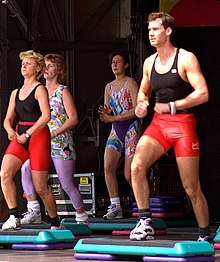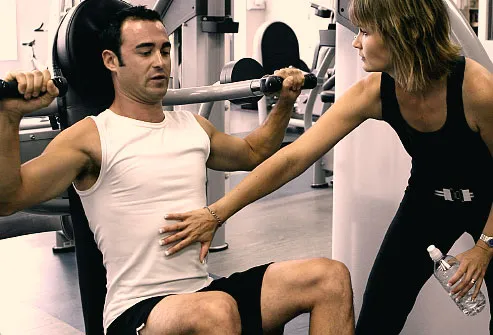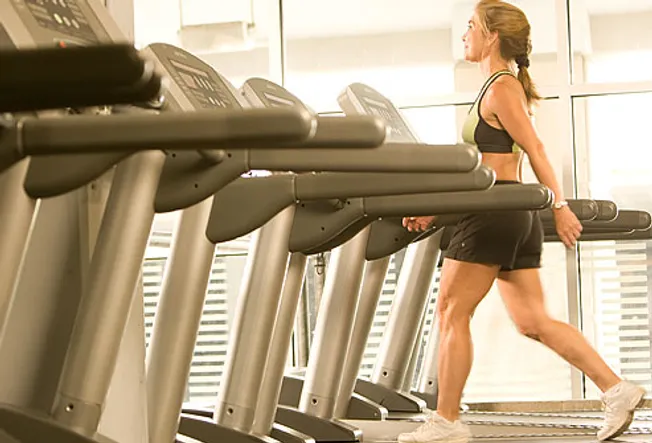
Aerobic exercise (also known as cardio) is physical exercise of low to high intensity that depends primarily on the aerobic energy-generating process.Aerobic literally means "relating to, involving, or requiring free oxygen",and refers to the use of oxygen to adequately meet energy demands during exercise via aerobic metabolism. Generally, light-to-moderate intensity activities that are sufficiently supported by aerobic metabolism can be performed for extended periods of time.
When practiced in this way, examples of cardiovascular/aerobic exercise are medium to long distance running/jogging, swimming, cycling, and walking, according to the first extensive research on aerobic exercise, conducted in the 1960s on over 5,000 U.S. Air Force personnel by Dr. Kenneth H. Cooper.
History
Kenneth Cooper was the first person to introduce the concept of aerobic exercise. In the 1960s, Cooper started research into preventive medicine. He became intrigued by the belief that exercise can preserve one's health. In 1970 he created his own institute (the Cooper Institute) for non-profit research and education devoted to preventive medicine. He sparked millions into becoming active and is now known as the "father of aerobics".
Aerobic versus anaerobic exercise
This section needs additional citations for verification. Relevant discussion may be found on the talk page. Please help improve this article by adding citations to reliable sources. Unsourced material may be challenged and removed. (October 2011) (Learn how and when to remove this template message)
Fox and Haskell formula showing the split between aerobic (light orange) and anaerobic (dark orange) exercise and heart rate
Aerobic exercise and fitness can be contrasted with anaerobic exercise, of which strength training and short-distance running are the most salient examples. The two types of exercise differ by the duration and intensity of muscular contractions involved, as well as by how energy is generated within the muscle.
New research on the endocrine functions of contracting muscles has shown that both aerobic and anaerobic exercise promote the secretion of myokines, with attendant benefits including growth of new tissue, tissue repair, and various anti-inflammatory functions, which in turn reduce the risk of developing various inflammatory diseases. Myokine secretion in turn is dependent on the amount of muscle contracted, and the duration and intensity of contraction. As such, both types of exercise produce endocrine benefits.
In almost all conditions, anaerobic exercise is accompanied by aerobic exercises because the less efficient anaerobic metabolism must supplement the aerobic system due to energy demands that exceed the aerobic system's capacity. What is generally called aerobic exercise might be better termed "solely aerobic", because it is designed to be low-intensity enough not to generate lactate via pyruvate fermentation, so that all carbohydrate is aerobically turned into energy.
Initially during increased exertion, muscle glycogen is broken down to produce glucose, which undergoes glycolysis producing pyruvate which then reacts with oxygen (Krebs cycle, Chemiosmosis) to produce carbon dioxide and water and releases energy. If there is a shortage of oxygen (anaerobic exercise, explosive movements), carbohydrate is consumed more rapidly because the pyruvate ferments into lactate. If the intensity of the exercise exceeds the rate with which the cardiovascular system can supply muscles with oxygen, it results in buildup of lactate and quickly makes it impossible to continue the exercise. Unpleasant effects of lactate buildup initially include the burning sensation in the muscles, and may eventually include nausea and even vomiting if the exercise is continued without allowing lactate to clear from the bloodstream.
As glycogen levels in the muscle begin to fall, glucose is released into the bloodstream by the liver, and fat metabolism is increased so that it can fuel the aerobic pathways. Aerobic exercise may be fueled by glycogen reserves, fat reserves, or a combination of both, depending on the intensity. Prolonged moderate-level aerobic exercise at 65% VO2 max (the heart rate of 150 bpm for a 30-year-old human) results in the maximum contribution of fat to the total energy expenditure. At this level, fat may contribute 40% to 60% of total, depending on the duration of the exercise. Vigorous exercise above 75% VO2max (160 bpm) primarily burns glycogen.
Major muscles in a rested, untrained human typically contain enough energy for about 2 hours of vigorous exercise. Exhaustion of glycogen is a major cause of what marathon runners call "hitting the wall". Training, lower intensity levels, and carbohydrate loading may allow postponement of the onset of exhaustion beyond 4 hours.
Aerobic exercise comprises innumerable forms. In general, it is performed at a moderate level of intensity over a relatively long period of time. For example, running a long distance at a moderate pace is an aerobic exercise, but sprinting is not. Playing singles tennis, with near-continuous motion, is generally considered aerobic activity, while golf or two person team tennis, with brief bursts of activity punctuated by more frequent breaks, may not be predominantly aerobic. Some sports are thus inherently "aerobic", while other aerobic exercises, such as fartlek training or aerobic dance classes, are designed specifically to improve aerobic capacity and fitness. It is most common for aerobic exercises to involve the leg muscles, primarily or exclusively. There are some exceptions. For example, rowing to distances of 2,000 m or more is an aerobic sport that exercises several major muscle groups, including those of the legs, abdominals, chest, and arms. Common kettlebell exercises combine aerobic and anaerobic aspects.
Benefits
Among the recognized benefits of doing regular aerobic exercise are:
Strengthening the muscles involved in respiration, to facilitate the flow of air in and out of the lungs
Strengthening and enlarging the heart muscle, to improve its pumping efficiency and reduce the resting heart rate, known as aerobic conditioning
Improving circulation efficiency and reducing blood pressure
Increasing the total number of red blood cells in the body, facilitating transport of oxygen
Improved mental health, including reducing stress and lowering the incidence of depression, as well as increased cognitive capacity.
Reducing the risk for diabetes. One meta-analysis has shown, from multiple conducted studies, that aerobic exercise does help lower Hb A1Clevels for type 2 diabetics.
As a result, aerobic exercise can reduce the risk of death due to cardiovascular problems. In addition, high-impact aerobic activities (such as jogging or using a skipping rope) can stimulate bone growth, as well as reduce the risk of osteoporosis for both men and women.
In addition to the health benefits of aerobic exercise, there are numerous performance benefits:
Increased storage of energy molecules such as fats and carbohydrates within the muscles, allowing for increased endurance
Neovascularization of the muscle sarcomeres to increase blood flow through the muscles
Increasing speed at which aerobic metabolism is activated within muscles, allowing a greater portion of energy for intense exercise to be generated aerobically
Improving the ability of muscles to use fats during exercise, preserving intramuscular glycogen
Enhancing the speed at which muscles recover from high intensity exercise
Neurobiological effects: improvements in brain structural connections and increased gray matter density, new neuron growth, improved cognitive function (cognitive control and various forms of memory), and improvement or maintenance of mental health
Some drawbacks of aerobic exercise include:
Overuse injuries because of repetitive, high-impact exercise such as distance running.
Is not an effective approach to building muscle.
Only effective for fat loss when used consistently.
Both the health benefits and the performance benefits, or "training effect", require a minimum duration and frequency of exercise. Most authorities suggest at least twenty minutes performed at least three times per week.
Cooper himself defines aerobic exercise as the ability to utilize the maximum amount of oxygen during exhaustive work. Cooper describes some of the major health benefits of aerobic exercise, such as gaining more efficient lungs by maximizing breathing capacity, thereby increasing ability to ventilate more air in a shorter period of time. As breathing capacity increases, one is able to extract oxygen more quickly into the blood stream, increasing elimination of carbon dioxide. With aerobic exercise the heart becomes more efficient at functioning, and blood volume, hemoglobin and red blood cells increase, enhancing the ability of the body to transport oxygen from the lungs into the blood and muscles. Metabolism will change and enable consumption of more calories without putting on weight. Aerobic exercise can delay osteoporosis as there is an increase in muscle mass, a loss of fat and an increase in bone density. With these variables increasing, there is a decrease in likelihood of diabetes as muscles use sugars better than fat. One of the major benefits of aerobic exercise is that body weight may decrease slowly; it will only decrease at a rapid pace if there is a calorie restriction, therefore reducing obesity rates.
Quick links
Walking
Running
Swimming
Aquarobics
Cycling
Rowing
Boxing
Aerobic or ‘cardio’ classes
Team sports
Dancing
Starting a new exercise program?
Further information
Sources
Walking
Let’s look at some of the ways a walking habit can improve your health:
Better cardiovascular fitness
Stronger leg muscles
Lower blood pressure
Lower risk of heart disease, diabetes, bowel cancer and osteoporosis.
It’s also a safe, low-impact exercise that most people can do — and it’s especially good if you’re overweight, unused to physical activity or pregnant.
Walking for 30 minutes a day at moderate intensity is great. Walking for a longer period of time is better still. As you get fitter, you will be able to walk more briskly. Walking up and down hills will also help to boost stamina and leg strength. You’ll get even more benefits from a walk if you swing your arms as this helps you walk faster and can burn 5 to 10 percent more kilojoules.
Things to consider
If weight loss is your goal, the National Heart Foundation of Australia recommends you walk at a moderate intensity for 45 minutes to an hour on most days of the week to lose weight and keep it off.
Running
Like walking, running is an inexpensive exercise you can do anywhere at a time that suits you. It is beneficial in helping to improve heart and bone health. Its advantage over walking is that it improves heart fitness and burns kilojoules at a greater rate. It takes roughly an hour for a walker to burn the same number of kilojoules that a runner burns in 30 minutes.
Jogging is running at a slower pace which is still a great aerobic exercise. Like walking, running or jogging can be a social activity you can do with a friend or in a group. Many areas have running clubs which welcome runners of all skill levels.
Things to consider
Running is a high-impact exercise so the injury risk is higher than with walking. Common problems include injuries to the knee, shin splints and ankle sprains. If you can, you should aim to run on dirt tracks or grass rather than on the road as this puts less stress on the feet and knees. Runners and joggers need well-fitted running shoes designed to cushion the impact of running. If you’re not normally active, it’s important to start with regular walking first before gradually building up to jogging or running, and speak to your doctor before starting any new exercise program.
Swimming
If it’s too hot to walk or run, swimming can be a cool way to get fit. It’s a low-cost workout for the whole body especially the muscles of the back, shoulder and arms and improves flexibility as well. It’s a good way to exercise if you’re overweight, pregnant or have joint problems as the water helps support your weight and can reduce the pressure on your joints. The risk of injury to muscles, ligaments or joints is also low.
Things to consider
It’s less effective for weight loss compared to walking or running. And because it’s not a weight-bearing exercise, it doesn’t reduce the risk of bone loss. If you’re swimming outdoors, remember to use sunscreen and reapply at regular intervals.
Aquarobics
These exercise sessions are done in a swimming pool and are available at some fitness centres or through local community health services. Aquarobics is a low-impact way to improve heart fitness and muscle strength without stressing the joints. It’s particularly suitable for anyone who’s pregnant, has joint problems and is overweight or unused to exercise.
Things to consider
Like swimming, aquarobics is less effective for weight loss and doesn’t improve bone strength.
Cycling
Cycling does double duty as an aerobic workout as well as being a low-cost, eco-friendly form of transport. It’s good exercise for improving leg strength and toning leg and buttock muscles — but with less stress on joints compared to running or walking. If you’d rather not ride outdoors, exercise bikes at home or in a gym are a good alternative.
Spinning classes available at some fitness centres are another indoor cycling option. These involve simulating different biking activities on a stationary bike — for example, cycling uphill or sprints — and are choreographed to music.
Things to consider
If you ride outdoors a helmet is essential, as well as reflective clothing if you ride when it’s dark. You need to maintain your bike so that it’s safe to ride and know how to ride safely on the road.
Rowing
Rowing is a low-impact alternative to running or cycling that can improve heart fitness and strengthen the muscles of the upper body, back and abdomen. You can enjoy rowing outdoors by joining a rowing club or hiring a rowboat, or indoors using a rowing machine at the gym or at home.
Things to consider
Whether you’re rowing on water or indoors, it’s important to use the correct technique to avoid injury, especially to the lower back. Other common injuries include knee pain, tendonitis in the wrist and blisters on your hands. If you join a club, you should get advice on technique from the coach; if you use a rowing machine at the gym, ask a qualified instructor. If you row outdoors, you also need to be able to swim and wear a life jacket, know how to row safely — and remember to use sunscreen!
Boxing
This is a good aerobic workout that also boosts upper body strength — and helps you let off steam. Boxing classes are widely available in many gyms. Some classes involve sparring with a partner — you take it in turns to hold a pad or pads while the other person punches them while wearing boxing mitts. Others involve no mitts or pads, just air punching and other moves that simulate boxing training. You can also use a punching bag either at the gym or in your own home.
Things to consider
You need hand-eye coordination to punch a pad or punching bag so it may be trickier than you think — but you’ll soon improve with regular practice. You won’t get a black eye because there’s no combat involved, but there’s a risk of injury to hands and wrists if you’re punching a pad or punching bag. Many gyms provide boxing mitts, however you’ll need to bring your own cotton gloves to wear inside.
Aerobic or ‘cardio’ classes
Available in most gyms and community centres, these classes keep you moving to music using a variety of different exercises that raise your heart rate.
Things to consider
Classes can vary in their intensity with some classes more suited to beginners than others — so check first. As with running there’s always the chance of injury to knees or ankles, but a good instructor should ensure you exercise correctly to reduce the risk. You may not need to join a gym full time to take advantage of aerobic classes as many gyms offer casual classes.
Team sports
Fast-paced sports such as soccer, netball or basketball provide an aerobic workout, improve muscle and bone strength — and provide a social activity as well.
Things to consider
There’s a risk of injury especially to knees and ankles. You’ll need to fit training and match commitments into your schedule.
Dancing
Faster styles of dancing such as jazz, hip hop, African and Latin American can provide an aerobic workout and improve flexibility and bone strength as well as being a lot of fun. It’s also an indoor activity you can do in all weather conditions. Dancing classes are available in many community centres, gyms and dance schools.
Things to consider
You may need special shoes, depending on the dance style you choose.
Starting a new exercise program?
Always check with your doctor first if you’re pregnant, over 40, inactive, have heart disease or a family history of heart disease or have any major health problems.
Sources
University of California Berkeley Foundations of Wellness. A dozen ways to improve your walking workouts. [online] Palm Coast, FL: Remedy Health Media. c2010 [accessed 16 Aug 2010] Available from: http://www.wellnessletter.com/html/fw/fwFit04Walking.html
Go for your life. Sports and Activities. [online] Melbourne, VIC: State of Victoria. c2006 [last updated 10 Aug 2010, accessed 16 Aug 2010] Available from: http://www.goforyourlife.vic.gov.au/
National Heart Foundation of Australia. Physical activity in the prevention and management of type 2 diabetes. [online] Australia: National Heart Foundation of Australia. 2009 [accessed 11 Aug 2010] Available from: http://www.heartfoundation.org.au/
https://www.webmd.com/fitness-exercise/ss/slideshow-7-most-effective-exercises#next


No comments:
Post a Comment